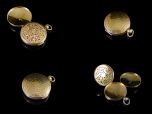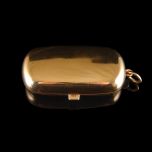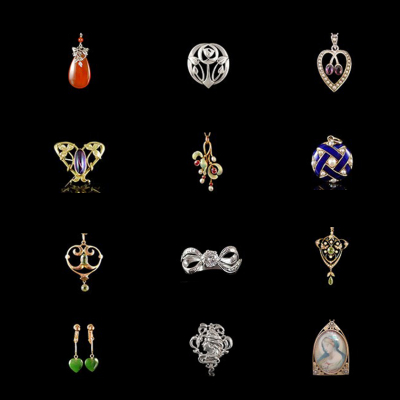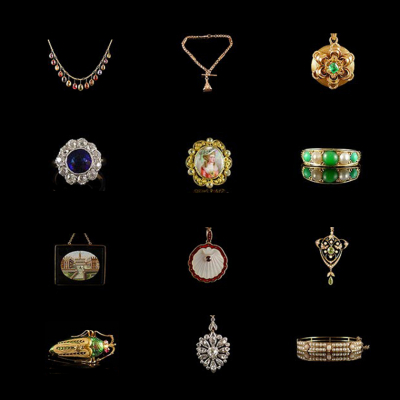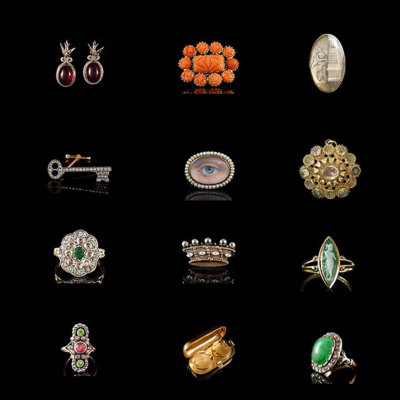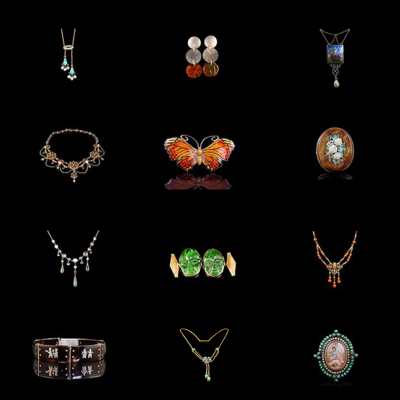GEORGIAN JEWELLERY (1714-1837)
Georgians tended to reflect the tastes and attitudes of the people of the period, resulting in rather mixed bag of styles and materials employed. This is not a surprise as the term 'Georgian Jewellery' refers to a period which spans over 120 years and includes the reigns of 4 British monarchs all with the title King George (I-IV).
As time has gone by Georgian jewellery has become increasingly rare and in turn can command high prices for very sought after pieces. Often featuring nature-inspired designs such as leaves and birds, Georgian jewellery frequently includes precious stones. Memento Mori jewellery was also popular at the time (meaning 'remember you will die') and was quite morbid, featuring skull motifs and coffins.
Georgian jewellery was handmade, making the quality of each piece of jewelry variable. Georgian antique jewellery frequently includes precious stones and these would be set into foiled closed backed settings to the reverse, set in silver to the front.
Necklaces tended to be short, which flattered the low necklines of the times. Common styles included rivieres, which consisted of a row of graduated diamonds or gemstones; and cameos and mosaics worn en esclavage (several plaques with two or three rows of draped chain between each)
Jewellery has always been worn for many purposes; the reasons for wearing jewellery are more complicated than a basic desire for self adornment.
1672-1732: Pinchbeck jewellery was introduced as an imitation of Gold. Invented by Christopher Pinchbeck, it was a mixture of alloy, copper and zinc. Pinchbeck sold in large quantities and was eventually taken over by gilt metal. (Gilding is a process by which a base metal is plated or coated with a thin layer of gold).
1701-1773: Paste jewelry was introduced as a substitute for Diamonds. Jewellery invented by Georges Frederic Strass, paste was a high lead content glass and was cut to resemble Diamonds. Diamonds were purchased and worn by aristocracy, whilst paste jewellery was purchased and worn by the middle class.
People have worn antique jewellery as a memento of loved ones living or dead. Jewelry was also worn as an expression of faith or as a talisman to ward off evil and disease. It was a belief that certain stones had magical powers. Topaz cured madness and increased wisdom. Sapphire cured diseases of the skin.
Memento mori, meaning remember that you must die. Memento antique jewellery appeared in the 16th century and was decorated with enamel, skeletons, skulls, worms, coffins and crossbones.
By the 17th century memento jewellery and the above symbols were being used not to warn of mortality but to commemorate the death of individuals. By the second half of the 17th century memorial rings were being provided to distribute to family and friends after a funeral.
Antique jewellery; Memorial rings, lockets, pendants and slides (worn on ribbons around the neck or wrist) contained backgrounds of silk or hair with symbols of skulls and cross bones under crystal. By 1730 Antique jewellery with unsightly skulls and cross bones were followed by more neo-classical miniatures. Antique jewellery; Rings, pendants and brooches were decorated with sepia on ivory showing grieving women by tombs, urns and broken columns decorated with weeping willow and cherubs.
1781: Silhouettes were cheaper than painted miniatures and these were set in jewellery; rings, pendants or brooches. Also the miniature of a single eye was used in jewelry, some set with a glistening diamond tear drop.
1813-1815: Berlin Iron jewellery was founded at Gleiwitz in the Prussian province of Silesia. In 1804 a factory was established In Berlin producing iron objects both functional and decorative. Trade increased during the period 1813 -1815 as a response to a plea by the Prussian authorities for members of the aristocracy to donate gold and jewels for the war effort against Napoleon. In exchange for gold and jewels they were given Iron Work Crosses, brooches, necklaces and bracelets some bearing the inscription “Gold gab ich fur Eisen” (I gave gold for iron). The response was immense with over 41,000 items of Berlin Antique Ironwork jewellery being produced in 1814 alone
The Late Georgian period includes the reigns of British monarchs George III and IV, and William IV





